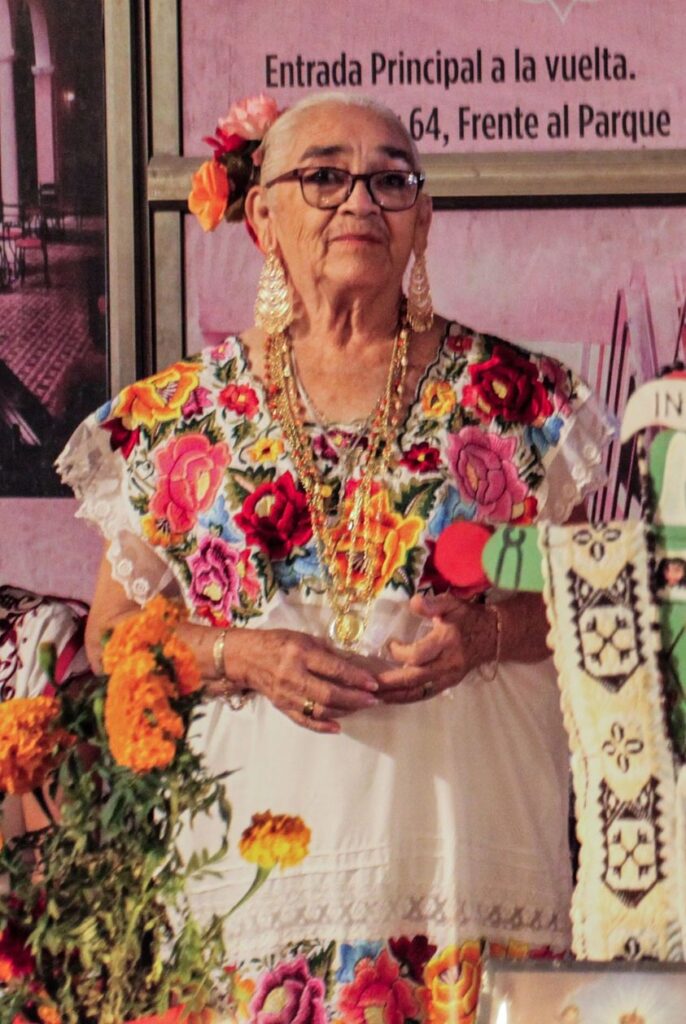
Quizá en este post me voy a escuchar un poco enojado y ofendido, ya que hablaremos de las llamadas “mestizas”, pero primero que son las mestizas en el estado de Yucatán.
Son las mujeres indígenas que visten con la clásica prenda llamada Hipil, que es la vestimenta tradicional de las mujeres de los pueblos en Yucatán, es una túnica holgada para contrarrestar el calor, es la vestimenta de uso diario. El Terno es la versión de Lujo del Hipil, que es usado en ocasiones especiales y que por el ardua trabajo tanto artístico u manual de elaboración es muy costoso actualmente, hay ternos que llegan a costar hasta $50,000 pesos
El terno, consta de tres piezas principales:
1. Jubón: Una solapa cuadrada que se une al cuello del hipil.
2. Hipil: Un saco cerrado que llega hasta las rodillas.
3. Fustán: Un medio fondo sujetado a la cintura que llega hasta los tobillos.
Perhaps in this post, I might sound a bit angry and offended, as we will talk about the so-called “mestizas.” But first, what are mestizas in the state of Yucatán?
They are indigenous women who wear the classic garment called Hipil, which is the traditional attire of the women from the villages in Yucatán. It is a loose tunic designed to counteract the heat and is used as everyday clothing. The Terno is the luxury version of the Hipil, used on special occasions, and due to the arduous artistic and manual work involved in its creation, it is very expensive nowadays. Some ternos can cost up to 50,000 pesos.
The Terno consists of three main pieces:
- Jubón: A square collar that attaches to the neck of the hipil.
- Hipil: A closed sack that reaches the knees.
- Fustán: A half-slip fastened at the waist that reaches the ankles.

La verdad es muy fácil reconocer a una mestiza en las calles. Mi enojo viene por el calificativo “mestizas “, ya que si nos basamos en la definición del Diccionario Real de la Lengua Española dice: “Dicho de una persona: Nacida de padre y madre de raza diferente, en especial de hombre blanco y mujer indígena, o de hombre indígena y mujer blanca”.
Pero, estas mujeres en su mayoría son Mayas puras, solo basta saber sus apellidos que son completamente Mayas. Ellas son, se podría decir raza Maya pura, de hecho, hasta hablan el idioma Maya.
Mestizos somos todos nosotros que tenemos apellidos españoles, no ellas.
Pero realmente eso no tiene tanta importancia, lo que si tiene importancias y me enoja es la discriminación de la que son víctimas por ser “mestizas”.
La mayoría de las personas las ven como algo inferior, personas sin educación, que solo son útiles para las labores domésticas, cuando es un hecho que son mujeres muy inteligentes, trabajadoras, bilingües (hablan Maya y español), en muchos casos emprendedoras, luchadoras y muy, pero muy pacientes, ya que toleran muchísimo a sus esposos borrachos. Seamos honestos, Yucatán es el estado número 1 en alcoholismo en México.
Sin embargo, su vestimenta y tradiciones reflejan una rica historia de mestizaje cultural y adaptación.
Como conclusión, las “mestizas” no son “mestizas, son mujeres de raza Maya pura con una historia, raíces y tradiciones mucho mas profundas que la mayoría de nosotros.
Este post es absolutamente necesario para sacar a la luz un tema tan sensible como la discriminación hacia las mujeres indígenas en Yucatán. Es increíble cómo estas personas son vistas como inferiores y solo útiles para labores domésticas, cuando en realidad son mujeres muy inteligentes, trabajadoras y emprendedoras.
Es verdad que su vestimenta tradicional, el hipil, es una parte importante de su identidad y cultura. Y no olvidemos que el terno, la versión de lujo del hipil, puede llegar a costar hasta $50,000 pesos debido al arduo trabajo manual que se requiere para elaborarlo.
Lo que me enoja es el calificativo «mestizas» que se les da a estas mujeres. Si nos basamos en la definición del Diccionario Real de la Lengua Española, una persona mestiza es aquella nacida de padre y madre de raza diferente, pero en este caso, las mujeres indígenas son mayas puras que hablan el idioma Maya.
Es hora de reconocer su valor y respetar su cultura. No podemos seguir discriminando a estas personas solo porque tienen apellidos mayas o por vistir con un hipil.
Esta foto es un recordatorio de la riqueza cultural que existen en Yucatán. Son mujeres felices y sobre todo son seres humanos igual que tu y yo.
Las mujeres indígenas en Yucatán son más que «mestizas», son mujeres valientes, trabajadoras y emprendedoras que merecen nuestro respeto y apoyo.
Esta foto fue tomada en una Cámara Canon RP y un lente con adaptador de montura EF a RF con un lente EF-S de 50 – 250mm, si eso lente barato que viene de Kit.
It is very easy to recognize a mestiza on the streets. My anger comes from the term “mestizas,” because if we base it on the definition from the Royal Spanish Academy Dictionary, it says: “Said of a person: Born of parents of different races, especially of a white man and an indigenous woman, or an indigenous man and a white woman.”
But these women are mostly pure Mayas; you only need to know their surnames, which are completely Mayan. They are, you could say, pure Maya race; in fact, they even speak the Maya language. We are the mestizos, those of us with Spanish surnames, not them.
But that is not really important. What is important and makes me angry is the discrimination they face for being “mestizas.” Most people see them as inferior, uneducated, and only useful for domestic work, when in fact, they are very intelligent, hardworking, bilingual (they speak Maya and Spanish), and in many cases, entrepreneurs, fighters, and very, very patient, as they tolerate their drunk husbands a lot. Let’s be honest, Yucatán is the number one state in Mexico for alcoholism.
However, their clothing and traditions reflect a rich history of cultural mestizaje and adaptation.
In conclusion, the “mestizas” are not “mestizas”; they are women of pure Maya race with a history, roots, and traditions much deeper than most of us.
This post is absolutely necessary to bring to light such a sensitive issue as the discrimination against indigenous women in Yucatán. It is incredible how these people are seen as inferior and only useful for domestic work, when in reality, they are very intelligent, hardworking, and in some cases, entrepreneurial women.
It is true that their traditional clothing, the hipil, is an important part of their identity and culture. And let’s not forget that the terno, the luxury version of the hipil, can cost up to 50,000 pesos due to the arduous manual work required to make it.
What makes me angry is the term “mestizas” given to these women. If we base it on the definition from the Royal Spanish Academy Dictionary, a mestizo person is one born of parents of different races, but in this case, the indigenous women are pure Mayas who speak the Maya language.
It is time to recognize their value and respect their culture. We cannot continue to discriminate against these people just because they have Mayan surnames or wear a hipil. This photo is a reminder of the cultural richness that exists in Yucatán. They are happy women and, above all, they are human beings just like you and me.
Indigenous women in Yucatán are more than “mestizas”; they are brave, hardworking, and entrepreneurial women who deserve our respect and support.
This photo was taken with a Canon RP camera and a lens with an EF to RF mount adapter with an EF-S 50-250mm lens, yes, that cheap kit lens.






